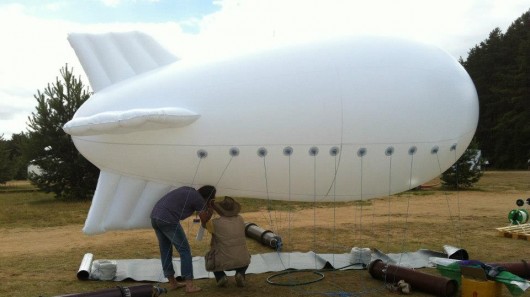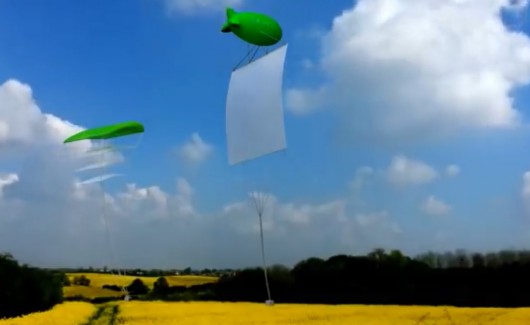Air HES system to collect water and generate electricity from the clouds
August 27, 2014

According to the designers, they have produced and flown a scale prototype of the blimp
Using a tethered airship floating high up among the clouds, the Air HES concept is designed to yield both clean water and electricity by harvesting and condensing water vapor, which it uses to spin up an electric turbine generator to create power. The developers behind the concept claim to have built a prototype to test their theory and have also conducted feasibility studies into upping the scale of their device to produce economically viable levels of water and power.
Using three proven technologies – water vapor condensers, hydroelectric generators, and airships – the Air HES (HydroElectric Station) is planned to be released up to a level of around 7,000 ft (2,100 m) to reach the mid-level clouds in the troposphere. Once there, it will use a large curtain of vapor-condensing mesh (similar to the system developed by MIT) to collect water.
The water collected from this process will then be released down a lightweight pipe attached to the balloon, where it will provide a significant head of pressure on its way to the ground. Large enough, the creators say, to provide more than enough energy to rotate the turbine on an electric generator and generate electricity.
The designers say they have produced and flown a scale prototype of the blimp and water collection system, which they claim produced around 4 L (1.05 gal) of water per hour for each square meter of mesh at 4,000 ft (1,200 m). The hydroelectric system planned for use on the system was not tested in this instance, though the creators do state that they have secured a Russian patent for the concept.
They are now working toward constructing a full-size, fully functional prototype of the complete system, and one that will be large enough to produce significant amounts of water and electricity. The team calculates that as a balloon 60 ft (18 m) in diameter yields around 7,000 lb (3,175 kg) of lift, this will be more than a sufficient size to carry the expected weight of the vertical tether and the water load collected.
At this size, the team says that power output – based on water collected per square meter of surface area – will produces around 1.8 kW of electrical power per day for every 10 liters (2.6 gal) per square meter of surface area. Given the team's ultimate goal of a 1000 square meter (10,700 sq ft) mesh collection area, this would supposedly produce anything up to 185 kW per day, provided the predicted collection rates and energy conversion figures are correct.
To get the full-size system off the ground, the team has floated a crowdfunding campaign on Indiegogo, aiming to raise US$14,000 to build a working prototype. After the first prototype is operating, tested, and proven, the team hopes to attract further business investment to make the Air HES system a viable commercial proposition. This will then allow team members to pursue other proposed advances of their technology, including a kite-based variety for use as an emergency drinking water solution.
As such, the Air HES team also believes that its aerial system may provide other advantages, including ease of mobility and deployment on an as-needed basis for emergency power or drinking water, along with the possibility of using the flight platform to raise antenna systems for communications in remote areas.
No timeline has been provided for the release of a full-sized operational system, but the team has provided a comprehensive feasibility study (PDF) of the system.
The video below is the team’s Indiegogo pitch that shows the prototype in action.
Source: Air HES
